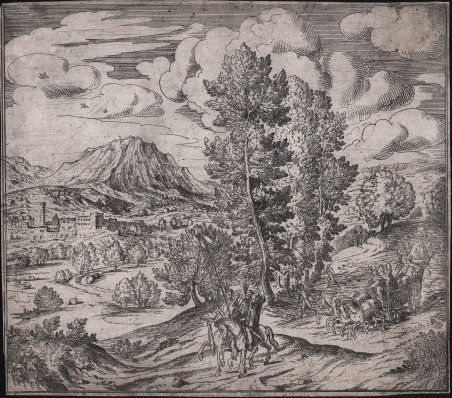Paesaggio rupestre nel classico stile veneto introdotto da Tiziano Vecellio e sviluppato, in particolare, da Domenico Campagnola. Incisione anonima, sconosciuta ai repertori bibliografici, conosciuta solo attraverso l’esemplare della Collezione Baselitz, pubblicato nel catalogo della mostra di Ginevra, presso il Cabinet des Estampes du Musee d'Art et d'Histoire, del 2002. Nella scheda descrittiva dell’opera si legge: “Per gli incisori veneziani e veronesi la rappresentazione di paesaggi sembra aver esercitato un'attrazione particolare nella seconda metà del Cinquecento, un interesse certamente inscindibile dalle precedenti esperienze di Tiziano e Domenico Campagnola. Battista del Moro, suo figlio Marco e Orazio Farinati si cimentano in questo genere, che include ricorrentemente un'architettura, alberi, un fiume e montagne. L'ambiente naturale così suggerito definisce l'atmosfera in cui si muovono le figure, organizzate in piccole scene narrative. Questa stampa anonima presenta quindi uno schema compositivo che ritroviamo in particolare in un Giovanni Battista Fontana, anche se qui la mano è completamente diversa e la definizione dell'immagine molto meno precisa rispetto all'artista veronese. Il punto di vista elevato mostra una compagnia di uomini che avanza verso lo spettatore, ed è difficile capire se si tratti di cacciatori o di viaggiatori con una scorta armata. L'occhio vaga poi verso il boschetto centrale di alberi, riempiendo l'allargamento della composizione ai lati, quindi verso la città e la campagna, prima di posarsi infine sulle montagne in lontananza. Il cielo è particolarmente ben fatto, con le nuvole che coronano la vasta distesa. La tonalità grigia dell'incisione, dovuta probabilmente ai numerosi graffi della lastra stessa, mostra la libertà grafica tipica dell'acquaforte, che permette di rendere i dettagli del terreno e la varietà della vegetazione. L'immagine è comunque da intendersi come naturalistica, anche se conserva un aspetto artificiale dovuto alla prospettiva ribassata, e non si vede traccia delle fantasie manieristiche caratteristiche delle composizioni prodotte intorno alla metà del secolo” (tradotto da N. Strasser, Le Beau Style (1520-1620) Gravures Manieristes de la Collection Georg Baselitz, p. 238). Acquaforte, impressa su carta vergata coeva con filigrana “aquila bicefala sormontata da corona” (la stessa dell’altro esemplare conosciuto della Collezione Baselitz), rifilata al rame, restauro all’angolo inferiore destro di circa 3 centimetri, per il resto in ottimo stato di conservazione. Opera rarissima. Bibliografia Natalie Strasser in “Le Beau Style (1520-1620) Gravures Manieristes de la Collection Georg Baselitz”, pp. 238-239, n. 103. Rock landscape in the classical Veneto style introduced by Titian Vecellio and developed, in particular, by Domenico Campagnola. Anonymous etching, undescribed by bibliographic repertories, known only through the Baselitz Collection example published in the 2002 catalog of the Geneva exhibition at the Cabinet des Estampes du Musee d'Art et d'Histoire. The work's descriptive note reads, "For Venetian and Veronese engravers, the depiction of landscapes seems to have exerted a particular attraction in the second half of the sixteenth century, an interest certainly inseparable from the earlier experiences of Titian and Domenico Campagnola. Battista del Moro, his son Marco, and Orazio Farinati tried their hand at this genre, which recurrently included architecture, trees, a river, and mountains. The natural environment thus suggested defines the atmosphere in which the figures move, organized in small narrative scenes. This anonymous print thus presents a compositional scheme that we find notably in a Giovanni Battista Fontana, although here the hand is completely different and the definition of the image much less precise than in the Veronese artist. The elevated viewpoint shows a company of men advancing toward the viewer, and it is difficult to tell whether they are hunters or travelers with an armed escort. The eye then wanders to the central grove of trees, filling the widening of the composition to the sides, then to the city and the countryside, before finally settling on the mountains in the distance. The sky is particularly well done, with clouds crowning the vast expanse. The gray tone of the engraving, probably due to the many scratches on the plate itself, shows the graphic freedom typical of etching, which allows the details of the terrain and the variety of vegetation to be rendered. The image is nevertheless to be understood as naturalistic, although it retains an artificial appearance due to the lowered perspective, and no trace is seen of the mannerist fantasies characteristic of compositions produced around mid-century" (translated from N. Strasser, Le Beau Style (1520-1620) Gravures Manieristes de la Collection Georg Baselitz, p. 238). Etching, printed on contemporary laid paper with watermark "two-headed eagle surmounted by crown" (the same as the other known example from the Baselitz Collection), trimmed to copper, restoration to lower right corner about 3 cm, otherwise in very good condition. A very rare work. Bibliografia Natalie Strasser in “Le Beau Style (1520-1620) Gravures Manieristes de la Collection Georg Baselitz”, pp. 238-239, n. 103. Cfr.

Find out how to use
Find out how to use

